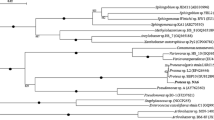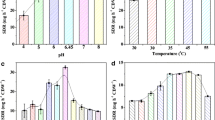Abstract
A salt-tolerant bacterium was isolated from the surface soil of a pharmaceutical factory, which could efficiently decolorize azo dyes. The strain was identified as Exiguobacterium sp. according to its morphological characteristics and 16S rRNA gene sequence analysis. Decolorization of X-3B with resting cells of this strain, which were catalyzed by redox mediator (anthraquinone), was studied, and the conditions were optimized. For color removal and cells growth, the optimal inoculation amount, pH, temperature, salinity, and metal ions were 6% (v/v), 5.4–7.0, 30–40 °C, 15% (w/v) NaCl, and 1 mmol L−1 Mg2+ or Ca2+, respectively. It was exhibited that decolorization process proceeded primarily by enzymatic reduction associated with a minor portion of bio-adsorption to inactivated microbial cells. Anthraquinone could really accelerate the decolorization of X-3B under the optimal conditions.







Similar content being viewed by others
References
Spadary, J. T., Isebelle, L., & Renganathan, V. (1994). Hydroxyl radical mediated degradation of azo dyes: Evidence for benzene generation. Environmental Science & Technology, 28(7), 1389–1393. doi:10.1021/es00056a031.
Sharma, M. K., & Sobti, R. C. (2000). Rec effect of certain textile dyes in Bacillus subtilis. Mutation Research, 465(1–2), 27–38.
Ganesh, R., Boardman, G. D., & Michelsen, D. (1994). Fate of azo dyes in sludges. Water Research, 28(6), 1367–1376. doi:10.1016/0043-1354(94)90303-4.
O’Neill, C., Hawkes, F. R., Hawkes, D. L., Esteves, S., & Wilcox, S. J. (2000). Anaerobic-aerobic biotreatment of simulated textile effluent containing varied ratios of starch and azo dye. Water Research, 34(8), 2355–2361. doi:10.1016/S0043-1354(99)00395-4.
O’Neill, C., Hawkes, F. R., Hawkes, D. L., Esteves, S., & Wilcox, S. J. (2000). Azo-dye degradation in an anaerobic-aerobic treatment system operating on simulated textile effluent. Applied Microbiology and Biotechnology, 53(2), 249–254. doi:10.1007/s002530050016.
Tan, N. C. G., Prenafest-Boldu, F. X., Opsteeg, J. L., Lettinga, G., & Field, J. A. (1999). Biodegradation of azo dyes in cocultures of anaerobic granular sludge with aerobic aromatic amine degrading enrichment cultures. Applied Microbiology and Biotechnology, 51(6), 865–871. doi:10.1007/s002530051475.
Yu, J., Chen, H., Ji, M., & Yue, P. L. (2000). Distribution and change of microbial activity in combined UASB and AFB reactors for wastewater treatment. Bioprocess Engineering, 22(4), 315–322. doi:10.1007/s004490050738.
Manu, B., & Chauhari, S. (2003). Decolorization of indigo and azo dyes in semicontinuous reactors with long hydraulic retention time. Process Biochemistry, 38, 1213–1221. doi:10.1016/S0032-9592(02)00291-1.
Van der Zee, F. P., Lettinga, G., & Field, J. A. (2001). Azo dye decolourisation by anaerobic granular sludge. Chemosphere, 44(5), 1169–1176. doi:10.1016/S0045-6535(00)00270-8.
Dos Santos, A. B., Cervantes, F. J., & Van Lier, J. B. (2004). Azo dye reduction by thermophilic anaerobic granular sludge, and the impact of the redox mediator anthraquinone-2,6-disulfonate (AQDS) on the reductive biochemical transformation. Applied Microbiology and Biotechnology, 64(1), 62–69. doi:10.1007/s00253-003-1428-y.
Van Der Zee, F. P., Bisschops, I. A. E., Lettinga, G., & Field, J. A. (2003). Activated carbon as an electron acceptor and redox mediator during the anaerobic biotransformation of azo dyes. Environmental Science & Technology, 37(2), 402–408. doi:10.1021/es025885o.
Russ, R., Rau, J., & Stolz, A. (2000). The function of cytoplasmatic flavin reductases in the bacterial reduction of azo dyes. Applied and Environmental Microbiology, 66(4), 1429–1434. doi:10.1128/AEM.66.4.1429-1434.2000.
Van der Zee, F. P., Lettinga, G., & Field, J. A. (2000). The role of (auto) catalysis in the mechanism of anaerobic azo reduction. Water Science and Technology, 42(5–6), 301–308.
Bechtold, T., Burtscher, E., & Turcanu, A. J. (1999). Anthraquinones as mediators for the indirect cathodic reduction of dispersed organic dyestuffs. Journal of Electroanalytical Chemistry, 465, 80–87. doi:10.1016/S0022-0728(99)00057-1.
Ponder, M. A., Thomashow, M. F., & Tiedje, J. M. (2008). Metabolic activity of Siberian permafrost isolates, Psychrobacter arcticus and Exiguobacterium sibiricum, at low water activities. Extremophiles, 12(4), 481–490. doi:10.1007/s00792-008-0151-0.
Joshi, A. A., Kanekar, P. P., Kelkar, A. S., Shouche, Y. S., Vani, A. A., Borgave, S. B., et al. (2008). Cultivable bacterial diversity of alkaline Lonar lake, India. Microbial Ecology, 55(2), 163–172. doi:10.1007/s00248-007-9264-8.
Vishnivetskaya, T. A., Siletzky, R., Jefferies, N., Tiedje, J. M., & Kathariou, S. (2007). Effect of low temperature and culture media on the growth and freeze-thawing tolerance of Exiguobacterium strains. Cryobiology, 54(2), 234–240. doi:10.1016/j.cryobiol.2007.01.008.
La Duc, M. T., Dekas, A., Osman, S., Moissl, C., Newcombe, D., & Venkateswaran, K. (2007). Isolation and characterization of bacteria capable of tolerating the extreme conditions of clean room environments. Applied and Environmental Microbiology, 73(8), 2600–2611. doi:10.1128/AEM.03007-06.
Kasana, R. C., & Yadav, S. K. (2007). Isolation of a psychrotrophic Exiguobacterium sp. SKPB5 (MTCC 7803) and characterization of its alkaline protease. Current Microbiology, 54(3), 224–229. doi:10.1007/s00284-006-0402-1.
Crapart, S., Fardeau, M. L., Cayol, J. L., Thomas, P., Sery, C., Ollivier, B., et al. (2007). Exiguobacterium profundum sp. nov., a moderately thermophilic, lactic acid-producing bacterium isolated from a deep-sea hydrothermal vent. International Journal of Systematic and Evolutionary Microbiology, 57(Pt 2), 287–292. doi:10.1099/ijs.0.64639-0.
Edlund, A., Jansson, J. K. (2008). Use of bromodeoxyuridine immunocapture to identify psychrotolerant phenanthrene-degrading bacteria in phenanthrene-enriched polluted Baltic Sea sediments. FEMS Microbiol Ecology, 65, 513–525.
Sivaprakasam, S., Mahadevan, S., Sekar, S., Rajakumar, S. (2008). Biological treatment of tannery wastewater by using salt-tolerant bacterial strains. Microbial Cell Factories, 7, 15.
López, L., Pozo, C., Rodelas, B., Calvo, C., Juárez, B., Martínez-Toledo, M. V., et al. (2005). Identification of bacteria isolated from an oligotrophic lake with pesticide removal capacities. Ecotoxicology (London, England), 14(3), 299–312. doi:10.1007/s10646-003-6367-y.
Sarangi, A., & Krishnan, C. (2008). Comparison of in vitro Cr (VI) reduction by CFEs of chromate resistant bacteria isolated from chromate contaminated soil. Bioresource Technology, 99(10), 4130–4137. doi:10.1016/j.biortech.2007.08.059.
Anderson, C. R., & Cook, G. M. (2004). Isolation and characterization of arsenate-reducing bacteria from arsenic-contaminated sites in New Zealand. Current Microbiology, 48(5), 341–347. doi:10.1007/s00284-003-4205-3.
Pattanapipitpaisal, P., Mabbett, A. N., Finlay, J. A., Beswick, A. J., Paterson-Beedle, M., Essa, A., et al. (2002). Reduction of Cr (VI) and bioaccumulation of chromium by gram positive and gram negative microorganisms not previously exposed to Cr-stress. Environmental Technology, 23(7), 731–745. doi:10.1080/09593332308618367.
Zimmermann, T., Kulla, H. G., & Leisinger, T. (1982). Properties of purified orange II azoreductase, the enzyme initiating azo dye degradation by Pseudomonas KF46. European Journal of Biochemistry, 129(1), 197–203. doi:10.1111/j.1432-1033.1982.tb07040.x.
Hsueh, C. C., & Chen, B. Y. (2008). Exploring effects of chemical structure on azo dye decolorization characteristics by Pseudomonas luteola. Journal of Hazardous Materials, 154(1–3), 703–710. doi:10.1016/j.jhazmat.2007.10.083.
Anjali, P., Poonam, S., & Leela, I. (2007). Bacterial decolorization and degradation of azo dyes. International Biodeterioration & Biodegradation, 59(2), 73–84. doi:10.1016/j.ibiod.2006.08.006.
Knapp, J. S., Newby, P. S., & Reece, L. P. (1995). Decolorization of dyes by wood-rotting basidiomycete fungi. Enzyme and Microbial Technology, 17(7), 664–668. doi:10.1016/0141-0229(94)00112-5.
Cànovas, M., Bernal, V., Sevilla, A., & Iborra, J. L. (2007). Salt stress effects on the central and carnitine metabolisms of Escherichia coli. Biotechnology and Bioengineering, 96(4), 722–737. doi:10.1002/bit.21128.
Jorg, R., Hans, J. K., & Andreas, S. (2002). Effects of different quinoid redox mediators on the anaerobic reduction of azo dyes by bacteria. Environmental Science & Technology, 36(7), 1497–1504. doi:10.1021/es010227+.
Acknowledgments
The authors gratefully acknowledge the financial support (no. 50608011) from the National Natural Science Foundation of China.
Author information
Authors and Affiliations
Corresponding author
Rights and permissions
About this article
Cite this article
Tan, L., Qu, Yy., Zhou, Jt. et al. Identification and Characteristics of A Novel Salt-Tolerant Exiguobacterium sp. for Azo Dyes Decolorization. Appl Biochem Biotechnol 159, 728–738 (2009). https://doi.org/10.1007/s12010-009-8546-7
Received:
Accepted:
Published:
Issue Date:
DOI: https://doi.org/10.1007/s12010-009-8546-7




